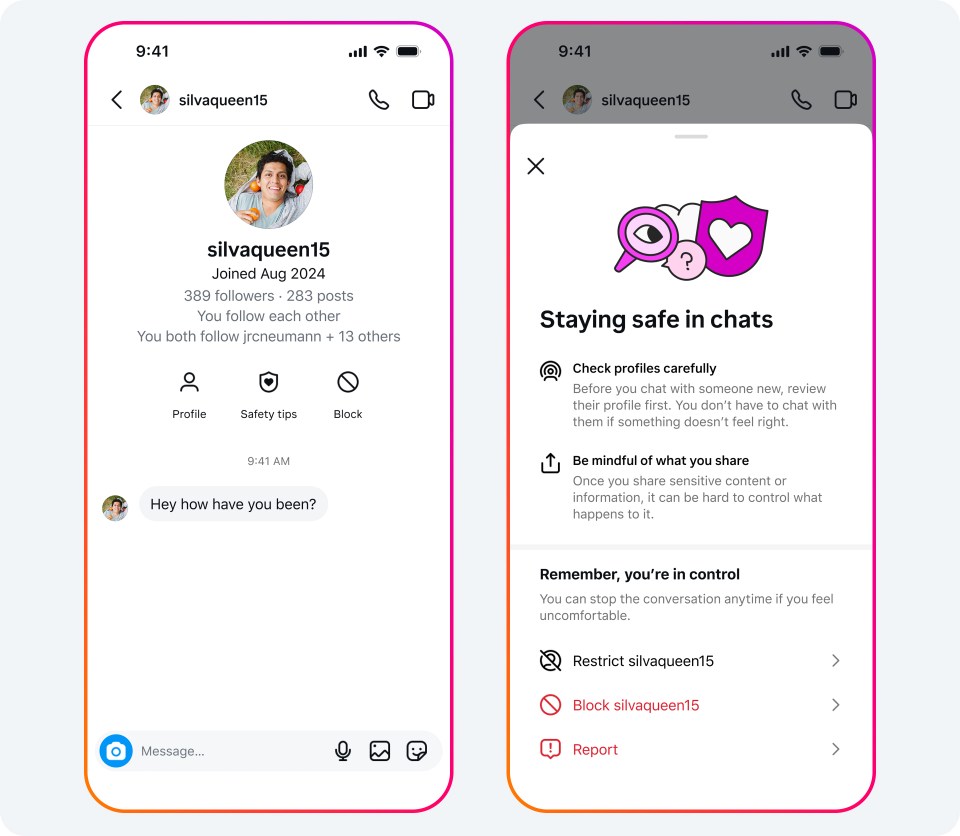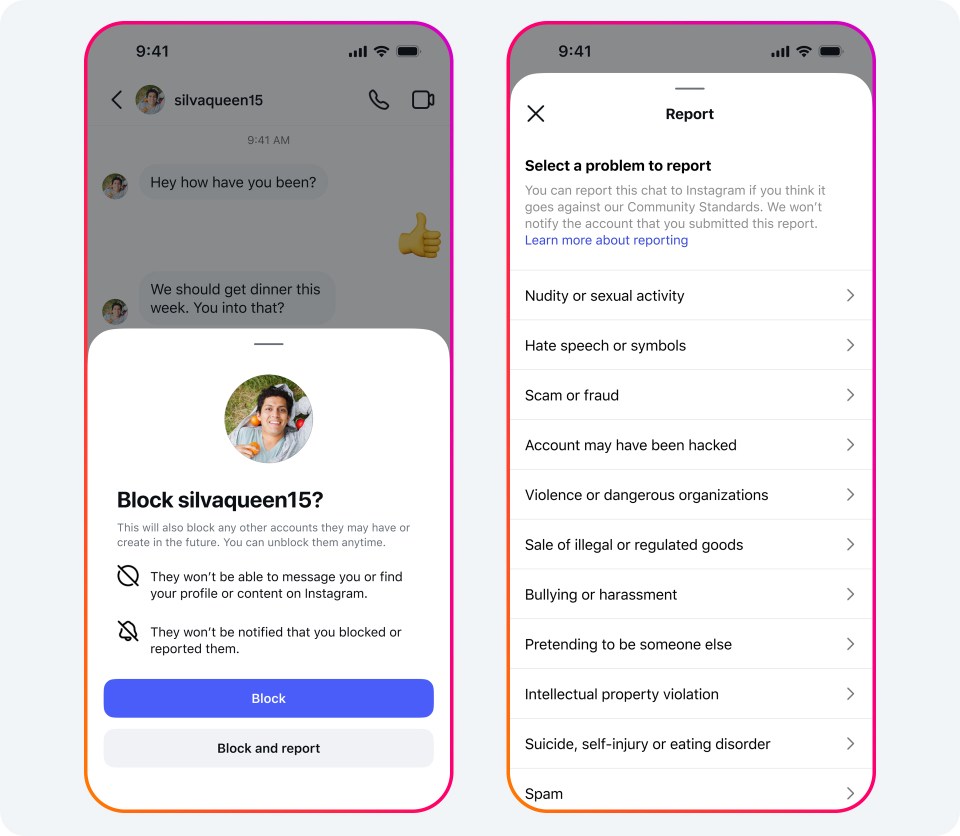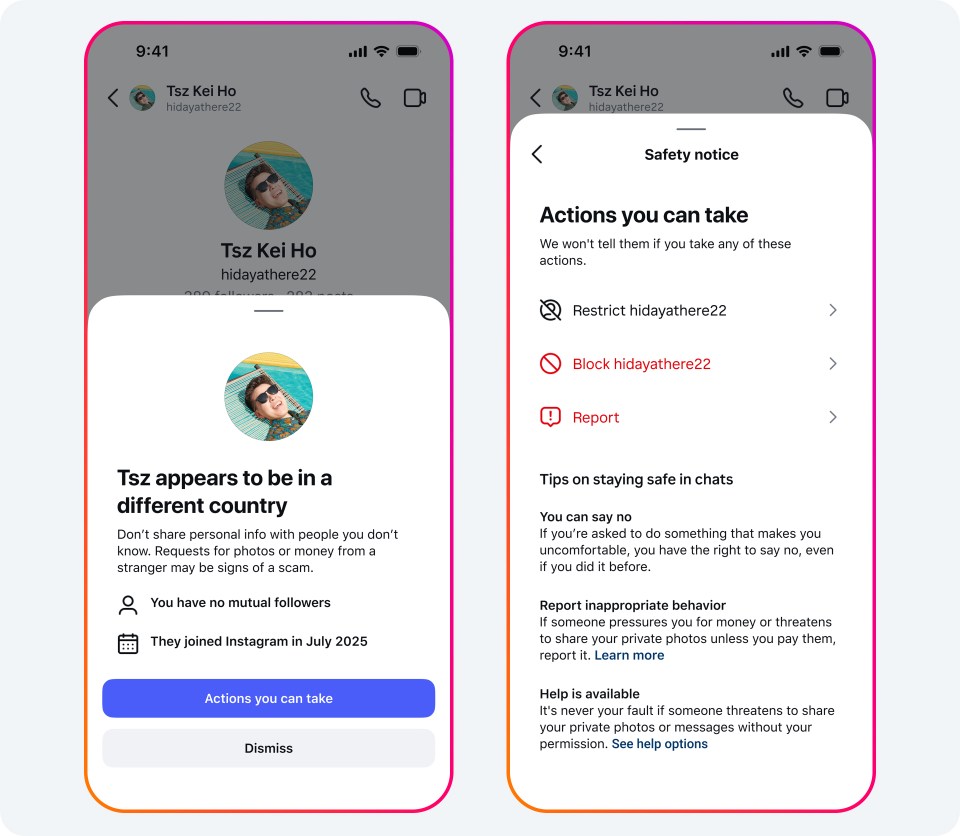At Meta, we work to protect young people from both direct and indirect harm. Our efforts range from Teen Accounts, which are designed to give teens age-appropriate experiences and prevent unwanted contact, to our sophisticated technology that finds and removes exploitative content.
Today, we’re announcing a range of updates to bolster these efforts, and we’re sharing new data on the impact of our latest safety tools.
Protecting Teens from Potentially Unsafe or Unwanted Contact
We’ve added new safety features to DMs in Teen Accounts to give teens more context about the accounts they’re messaging and help them spot potential scammers. Now, teens will see new options to view safety tips and block an account, as well as the month and year the account joined Instagram, all prominently displayed at the top of new chats.
We’ve also launched a new block and report option in DMs, so that people can take both actions together. While we’ve always encouraged people to both block and report, this new combined option will make this process easier, and help make sure potentially violating accounts are reported to us, so we can review and take action.
These new features complement the Safety Notices we show to remind people to be cautious in private messages and to block and report anything that makes them uncomfortable – and we’re encouraged to see teens responding to them. In June alone, they blocked accounts 1 million times and reported another 1 million after seeing a Safety Notice.
In June, teens and young adults also saw our new Location Notice on Instagram 1 million times, with 1 in 10 tapping on the notice to learn more about the steps they could take. Our Location Notice lets people know when they’re chatting with someone who may be in a different country, and is designed to help protect people from potential sextortion scammers who often misrepresent where they live.
Since rolling out our nudity protection feature globally, 99% of people – including teens – have kept it turned on, and in June, over 40% of blurred images received in DMs stayed blurred, significantly reducing exposure to unwanted nudity. Nudity protection, on by default for teens, also encourages people to think twice before forwarding suspected nude images, and in May people decided against forwarding around 45% of the time after seeing this warning.
Bringing Some Teen Account Protections to Adult-Managed Accounts Primarily Featuring Children
We’re also strengthening our protections for accounts run by adults that primarily feature children. These include adults who regularly share photos and videos of their children, and adults – such as parents or talent managers – who run accounts that represent teens or children under 13. While you have to be at least 13 to use Instagram, we allow adults to run accounts representing children under 13 if it’s clear in the account bio that they manage the account. If we become aware that the account is being run by the child themselves, we’ll remove it.
While these accounts are overwhelmingly used in benign ways, unfortunately there are people who may try to abuse them, leaving sexualized comments under their posts or asking for sexual images in DMs, in clear violation of our rules. Today we’re announcing steps to help prevent this abuse.
We’re extending some Teen Account protections to adult-managed accounts that primarily feature children. These include automatically placing these accounts into our strictest message settings to prevent unwanted messages, and turning on Hidden Words, which filters offensive comments. We’ll show these accounts a notification at the top of their Instagram Feed, letting them know we’ve updated their safety settings, and prompting them to review their account privacy settings too. These changes will roll out in the coming months.
We also want to prevent potentially suspicious adults, for example adults who have been blocked by teens, from finding these accounts in the first place. We’ll avoid recommending them to potentially suspicious adults and vice versa, make it harder for them to find each other in Search and hide comments from potentially suspicious adults on their posts. This builds on last year’s update to stop allowing accounts primarily featuring children to offer subscriptions or receive gifts.
Taking Action on Harmful Accounts Across the Internet
In addition to these new protections, we’re also continuing to take aggressive action on accounts that break our rules. Earlier this year, our specialist teams removed nearly 135,000 Instagram accounts for leaving sexualized comments or requesting sexual images from adult-managed accounts featuring children under 13. We also removed an additional 500,000 Facebook and Instagram accounts that were linked to those original accounts. We let people know that we’d removed an account that had interacted inappropriately with their content, encouraging them to be cautious and to block and report.
People who seek to exploit children don’t limit themselves to any one platform, which is why we also shared information about these accounts with other tech companies through the Tech Coalition’s Lantern program.






